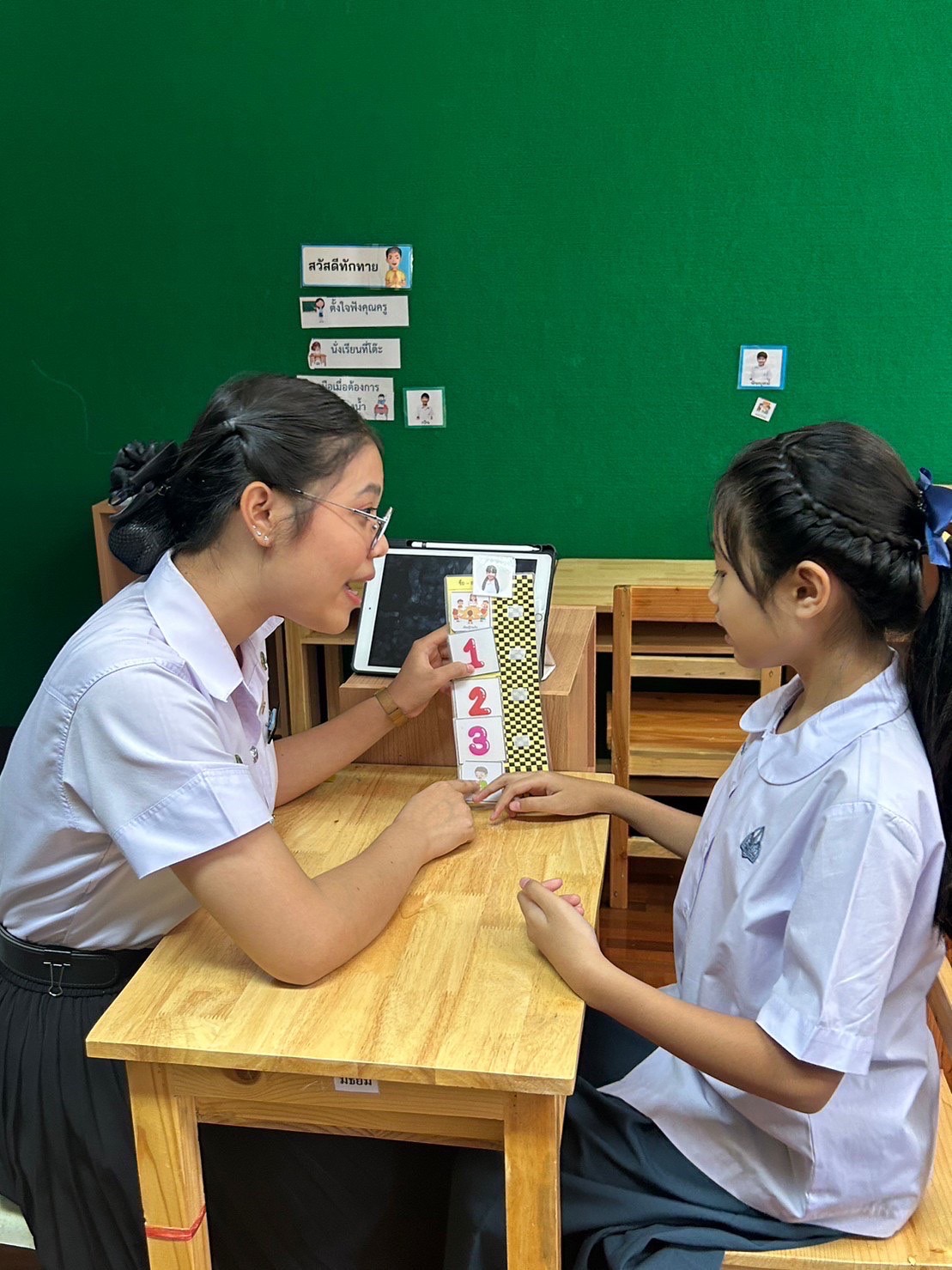สภาพปัจจุบันและความต้องการด้านการประเมินทักษะการคิดเชิงบริหารจัดการตนเอง สำหรับเด็กที่มีความต้องการพิเศษในศูนย์การศึกษาพิเศษ
Main Article Content
บทคัดย่อ
ทักษะการคิดเชิงบริหารจัดการตนเอง (Executive Functions: EF) เป็นกระบวนการที่ซับซ้อนที่ช่วยกำกับและควบคุมความคิดและพฤติกรรมมนุษย์เพื่อให้บรรลุเป้าหมายที่ตั้งไว้ได้ ศูนย์การศึกษาพิเศษเป็นหนึ่งช่องทางในการเพิ่มโอกาสทางการศึกษาสำหรับเด็กที่มีความต้องการพิเศษ ดังนั้นครูที่ดูแลเด็กเหล่านี้มีบทบาทสำคัญในการประเมิน ติดตาม ส่งเสริมและพัฒนาทักษะEF ให้กับเด็ก ปัจจุบันยังขาดการรายงานการศึกษาเกี่ยวกับความพร้อมของครู และความต้องการในการประเมินทักษะEF ของเด็กที่มารับบริการที่ศูนย์การศึกษาพิเศษ วัตถุประสงค์: 1) เพื่อสำรวจสภาพปัจจุบันของเด็กที่มีความต้องการพิเศษที่มารับบริการที่ศูนย์การศึกษาพิเศษ ความพร้อม ความรู้ ความเข้าใจของครู ที่ทำหน้าดูแลเด็กที่มีความต้องการพิเศษในการประเมินทักษะEF 2) ศึกษาความต้องการของครูในการใช้ประเมินทักษะEF สำหรับเด็กที่มีความต้องการพิเศษ ในศูนย์การศึกษาพิเศษ วิธีการวิจัย: โครงการวิจัยเชิงพรรณนานี้ สำรวจด้วยการใช้แบบสอบถามออนไลน์ตอบโดยครูที่ทำงานในศูนย์การศึกษาพิเศษทุกจังหวัดในประเทศไทย ผลการวิจัย: อาสาสมัครครูที่ศูนย์การศึกษาพิเศษ 77 ศูนย์ จำนวน 1,020 คน ร้อยละ 81.5 ไม่ได้ประเมินทักษะEF ของเด็กที่มีความต้องการพิเศษ ร้อยละ 90 ยังไม่รู้จักและไม่เคยใช้แบบประเมินทักษะดังกล่าว ผลการทดสอบพบว่า ครูมีความเข้าใจเกี่ยวกับพฤติกรรมที่เกี่ยวข้องกับความบกพร่องของทักษะEF แต่มีค่าเฉลี่ยคะแนนความรู้เกี่ยวกับทักษะ EF ค่อนข้างน้อย ร้อยละ 81.9 ของครูมีความต้องการใช้แบบประเมินทักษะEF นัยข้อค้นพบ: ผลการศึกษานี้เป็นข้อมูลเบื้องต้นนำไปสู่การพัฒนา หรือประยุกต์แบบประเมินมาตรฐานสำหรับครูเพื่อใช้ประโยชน์ทางการศึกษาในอนาคต
Article Details

อนุญาตภายใต้เงื่อนไข Creative Commons Attribution-NonCommercial-NoDerivatives 4.0 International License.
เอกสารอ้างอิง
จิระพร ซะโน และ ธนารัตน์ ศรีผ่องงาม. (2561). การศึกษาพัฒนาการด้านการคิดเชิงบริหารของเด็กปฐมวัย. วารสารศึกษาศาสตร์ มหาวิทยาลัยขอนแก่น, 42(3), 111-118.
นวลจันทร์ จุฑาภักดีกุล และคณะ. (2560). การพัฒนาและ หาค่าเกณฑ์มาตรฐานเครื่องมือ ประเมินการคิดเชิงบริหารในเด็กปฐมวัย. กรุงเทพฯ: ศูนย์วิจัยประสาทวิทยาศาสตร์ สถาบันชีววิทยาศาสตร์โมเลกุล, มหาวิทยาลัยมหิดล. 2560. 229 หน้า.
ระบบสารสนเทศการศึกษาพิเศษและการศึกษาสงเคราะห์. (2565). งานข้อมูลสารสนเทศกลุ่มแผนและงบประมาณสานักบริหารงานการศึกษาพิเศษ. ค้นเมื่อ 25 ธันวาคม 2565, จาก http://www.specialset.bopp.go.th
สมนึก ภัททิยธานี. (2550). ขั้นตอนการสร้างและหาคุณภาพของเครื่องมือที่ใช้เก็บข้อมูลเพื่อการทำวิจัย. วารสารศึกษาศาสตร์ มหาวิทยาลัยมหาสารคาม, 13(1), 1-11.
สำนักบริหารงานการศึกษาพิเศษ. (2555). แนวทางการพัฒนาสถานศึกษาต้นแบบการเรียนรวม. กรุงเทพฯ: สำนักงานคณะกรรมการการศึกษาขั้นพื้นฐาน.
สํานักบริหารงานการศึกษาพิเศษ สํานักงานคณะกรรมการการศึกษาขั้นพื้นฐาน. (2558). คู่มือหลักสูตรสําหรับเด็กที่มีความต้องการพิเศษระยะแรกเริ่มศูนย์การศึกษาพิเศษ. กรุงเทพฯ: คุรุสภาลาดพร้าว
สุภาวดี หาญเมธี และ คณะ. (2561). คู่มือพัฒนาทักษะสมอง EF Executive Functions สำหรับครูปฐมวัย. กรุงเทพฯ: เอกพิมพ์ไท.
อ้วนล่ำ ฐิตินันท์, และ แพงพรมมา นรุตม์. (2563). การพยาบาลเด็กออทิสติกที่มีพฤติกรรมก้าวร้าว. วารสารโรงพยาบาลมหาสารคาม, 17(2), 68-76.
American Psychiatric Association. (2013). Diagnostic and statistical manual of mental disorders (DSM-5). (5th ed). American Psychiatric Pub.
Anderson, P. (2002). Assessment and development of executive function (EF) during childhood. Child Neuropsychol, 8(2), 71-82.
Bunge, S. A., Hazeltine, E., Scanlon, M. D., Rosen, A. C., & Gabrieli, J. D. (2002). Dissociable contributions of prefrontal and parietal cortices to response selection. NeuroImage, 17(3), 1562–1571. https://doi.org/10.1006/nimg.2002.1252
Center on the Developing Child at Harvard University. (2011). Building the brain's "air traffic control"
Centers for Disease Control and Prevention. (2022). Data and Statistics on Autism Spectrum Disorder. Retrieved 5 August 2023, from https://www.cdc.gov/ncbddd/autism/data.html
Di Lieto, M. C., Castro, E., Pecini, C., Inguaggiato, E., Cecchi, F., Dario, P., Cioni, G., & Sgandurra, G. (2020). Improving Executive Functions at School in Children with Special Needs by Educational Robotics. Frontiers in psychology, 10, 2813.
Diamond, A. (2013). "Executive functions." Annu Rev Psychol, 64, 135-168.c
Fincham J. E. (2008). Response rates and responsiveness for surveys, standards, and the Journal. American journal of pharmaceutical education, 72(2), 43. https://doi.org/10.5688/aj720243
Gioia, G. A., Espy, K. A., & Isquith, P. K. (2003). Behavior Rating Inventory of Executive Function - Preschool Version. Psychological Assessment Resources.
McClelland, M. et al. (2014). Predictors of early growth in academic achievement: The head-toes-knees-shoulders task. Frontiers in psychology, 5(1), 599 (1-14).
Nilsen, E. S., Huyder, V., McAuley, T., & Liebermann, D. (2017). Ratings of Everyday Executive Functioning (REEF): A parent-report measure of preschoolers' executive functioning skills. Psychological assessment, 29(1), 50–64.
Roth, R. M., Isquith, P. K., & Gioia, G. A. (2014). Assessment of executive functioning using the Behavior Rating Inventory of Executive Function (BRIEF). Handbook of executive functioning, 301-331.
Rukmanee, B., Suradech, D., Suppawat, P., Saudamini, V., & Yot, T. (2019). Situation, Personal and Household Characteristics Associated with Disability in Children. Journal of Health Systems Research, 13(1).
Souissi, S., Chamari, K., & Bellaj, T. (2022). Assessment of executive functions in school-aged children: A narrative review. Frontiers in psychology, 13, 991699.
Sutipan, P. et al. (2012). The impact of the 101 s positive discipline teacher training on teacher practices and preschoolers' executive function skills. Mahidol University.
Turner, R. C., & Carlson, L. (2003). Indexes of Item-Objective Congruence for Multidimensional Items. International Journal of Testing, 3(2), 163–171.
Willoughby, M. et al. (2017). Developmental delays in executive function from 3 to 5 years of age predict kindergarten academic readiness. Journal of learning disabilities, 50(4), 359-372.
Zablotsky, B., Black, L. I., Maenner, M. J., Schieve, L. A., Danielson, M. L., Bitsko, R. H., Blumberg, S. J., Kogan, M. D., & Boyle, C. A. (2019). Prevalence and Trends of Developmental Disabilities among Children in the United States: 2009-2017. Pediatrics, 144(4), e20190811.


